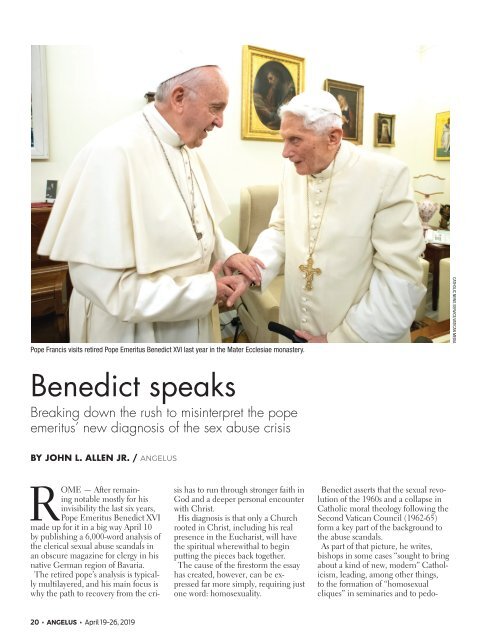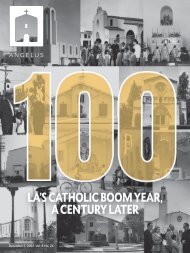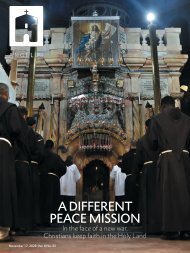Angelus News | April 19-26, 2019 | Vol. 4 No. 15
People hold candles during the Easter Vigil service at Westminster Cathedral on April 4, 2015, in London, England. Also known as the Paschal Vigil, the nocturnal liturgy celebrating the victory of Jesus Christ over death was for early Christians a night full of anticipation and dramatic symbols, rites, and singing. On page 10, contributing editor Mike Aquilina takes us back to the experience of the primitive Church to understand why the vigil was “the night of nights” for those Christians — and why it should still be for us, too. On page 16, Caitlin Yoshiko Kandil speaks to local catechumens about their road to conversion and why they’re looking forward to the “new life” of the baptism they’ll receive at this year’s Easter Vigil.
People hold candles during the Easter Vigil service at Westminster Cathedral on April 4, 2015, in London, England. Also known as the Paschal Vigil, the nocturnal liturgy celebrating the victory of Jesus Christ over death was for early Christians a night full of anticipation and dramatic symbols, rites, and singing. On page 10, contributing editor Mike Aquilina takes us back to the experience of the primitive Church to understand why the vigil was “the night of nights” for those Christians — and why it should still be for us, too. On page 16, Caitlin Yoshiko Kandil speaks to local catechumens about their road to conversion and why they’re looking forward to the “new life” of the baptism they’ll receive at this year’s Easter Vigil.
Create successful ePaper yourself
Turn your PDF publications into a flip-book with our unique Google optimized e-Paper software.
Pope Francis visits retired Pope Emeritus Benedict XVI last year in the Mater Ecclesiae monastery.<br />
CATHOLIC NEWS SERVICE/VATICAN MEDIA<br />
Benedict speaks<br />
Breaking down the rush to misinterpret the pope<br />
emeritus’ new diagnosis of the sex abuse crisis<br />
BY JOHN L. ALLEN JR. / ANGELUS<br />
ROME — After remaining<br />
notable mostly for his<br />
invisibility the last six years,<br />
Pope Emeritus Benedict XVI<br />
made up for it in a big way <strong>April</strong> 10<br />
by publishing a 6,000-word analysis of<br />
the clerical sexual abuse scandals in<br />
an obscure magazine for clergy in his<br />
native German region of Bavaria.<br />
The retired pope’s analysis is typically<br />
multilayered, and his main focus is<br />
why the path to recovery from the cri-<br />
sis has to run through stronger faith in<br />
God and a deeper personal encounter<br />
with Christ.<br />
His diagnosis is that only a Church<br />
rooted in Christ, including his real<br />
presence in the Eucharist, will have<br />
the spiritual wherewithal to begin<br />
putting the pieces back together.<br />
The cause of the firestorm the essay<br />
has created, however, can be expressed<br />
far more simply, requiring just<br />
one word: homosexuality.<br />
Benedict asserts that the sexual revolution<br />
of the <strong>19</strong>60s and a collapse in<br />
Catholic moral theology following the<br />
Second Vatican Council (<strong>19</strong>62-65)<br />
form a key part of the background to<br />
the abuse scandals.<br />
As part of that picture, he writes,<br />
bishops in some cases “sought to bring<br />
about a kind of new, modern” Catholicism,<br />
leading, among other things,<br />
to the formation of “homosexual<br />
cliques” in seminaries and to pedo-<br />
20 • ANGELUS • <strong>April</strong> <strong>19</strong>-<strong>26</strong>, 20<strong>19</strong>


















